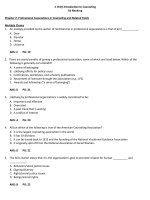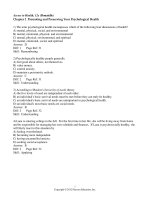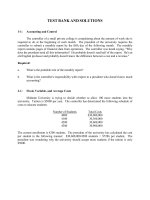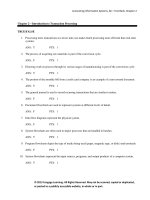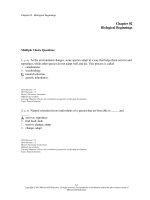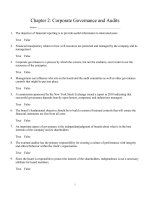Explorations introduction to astronomy 8th edition arny test bank
Bạn đang xem bản rút gọn của tài liệu. Xem và tải ngay bản đầy đủ của tài liệu tại đây (636.1 KB, 24 trang )
1. The Moon appears larger when it rises than when it is high in the sky because
A. you are closer to it when it rises (angular-size relation).
B. you are farther from it when it rises (angular-size relation).
C. it's an illusion from comparison to objects on the horizon.
D. it's brighter when it rises.
Accessibility: Keyboard Navigation
Blooms Level: 1. Remember
Difficulty: Easy
Gradable: automatic
Section: 02.01
Subtopic: Diameter-distance Relation (a.k.a. the small angle formula)
Subtopic: Observational astronomy
Topic: History of Astronomy
Topic: Locating Objects in the Sky
2. _________ was the first person to measure the circumference of the Earth.
A. Ptolemy
B. Copernicus
C. Eratsothenes
D. Galileo
E. Aristarchus
Accessibility: Keyboard Navigation
Blooms Level: 1. Remember
Difficulty: Easy
Gradable: automatic
Section: 02.01
Subtopic: Historical: Shape and Size of the Earth
Topic: History of Astronomy
3. When was it first known that the Earth was spherical in shape?
A. It was always known to be spherical
B. at the time of the Greeks
C. at the beginning of the Renaissance
D. only after Galileo used a telescope to study other planets
E. only recently within the last 100 hundred years
Accessibility: Keyboard Navigation
Blooms Level: 1. Remember
Difficulty: Easy
Gradable: automatic
Section: 02.01
Subtopic: Historical: Shape and Size of the Earth
Topic: History of Astronomy
2-1
Copyright © 2016 McGraw-Hill Education. All rights reserved. No reproduction or distribution without the prior written consent of
McGraw-Hill Education.
4. What is the size of an object located at a distance of 1,000 meters and that has angular size A = 4
degrees?
A. about 11 meters
B. about 35 meters
C. about 70 meters
D. about 4,000 meters
Accessibility: Keyboard Navigation
Blooms Level: 3. Apply
Difficulty: Medium
Gradable: automatic
Section: 02.01
Subtopic: Diameter-distance Relation (a.k.a. the small angle formula)
Topic: History of Astronomy
5. The angular size of an object increases as the distance to the observer increases.
FALSE
Accessibility: Keyboard Navigation
Blooms Level: 2. Understand
Difficulty: Medium
Gradable: automatic
Section: 02.01
Subtopic: Diameter-distance Relation (a.k.a. the small angle formula)
Topic: History of Astronomy
6. The angular size of the Sun as observed from Earth is about 0.5 degree.
TRUE
Accessibility: Keyboard Navigation
Blooms Level: 1. Remember
Difficulty: Medium
Gradable: automatic
Section: 02.01
Subtopic: Diameter-distance Relation (a.k.a. the small angle formula)
Subtopic: Historical: Distances and Sizes of the Sun and Moon
Topic: History of Astronomy
7. The angular size of the Moon as observed from Earth is about 0.5 degree.
TRUE
Accessibility: Keyboard Navigation
Blooms Level: 1. Remember
Difficulty: Medium
Gradable: automatic
Section: 02.01
Subtopic: Diameter-distance Relation (a.k.a. the small angle formula)
Subtopic: Historical: Distances and Sizes of the Sun and Moon
Topic: History of Astronomy
2-2
Copyright © 2016 McGraw-Hill Education. All rights reserved. No reproduction or distribution without the prior written consent of
McGraw-Hill Education.
8. One observation supporting the idea of a spherical Earth is that _________.
A. the shape of the Earth’s shadow on the Moon during an eclipse is circular
B. a traveler moving south will see stars they could not previously see
C. a ship moving away from the observer will move such that the hull is not seen, then the sails
D. all of these choices are correct
Accessibility: Keyboard Navigation
Blooms Level: 1. Remember
Difficulty: Easy
Gradable: automatic
Section: 02.01
Subtopic: Historical: Shape and Size of the Earth
Topic: History of Astronomy
9. The curved shape of the Earth’s shadow during an eclipse was evidence for _________.
A. a flat, circular Earth
B. a spherical Earth
C. a spherical Moon
D. A flat, circular Moon
E. None of these choices is correct
Accessibility: Keyboard Navigation
Blooms Level: 1. Remember
Difficulty: Easy
Gradable: automatic
Section: 02.01
Subtopic: Historical: Shape and Size of the Earth
Topic: History of Astronomy
10. Which of the following is a contribution that Eratosthenes made to astronomy?
A. He determined the circumference of the Earth.
B. He discovered epicycles.
C. He discovered his Three laws (of Planetary Motion).
D. He was the first person known to have pointed a telescope at the sky.
Accessibility: Keyboard Navigation
Blooms Level: 1. Remember
Difficulty: Easy
Gradable: automatic
Section: 02.01
Subtopic: Historical: Shape and Size of the Earth
Topic: History of Astronomy
2-3
Copyright © 2016 McGraw-Hill Education. All rights reserved. No reproduction or distribution without the prior written consent of
McGraw-Hill Education.
11. What is meant by the phrase "angular size"?
A. an object's diameter
B. how big an object looks, expressed as an angle
C. the distance around an object
D. the angle between two circular objects
Accessibility: Keyboard Navigation
Blooms Level: 1. Remember
Difficulty: Medium
Gradable: automatic
Section: 02.01
Subtopic: Diameter-distance Relation (a.k.a. the small angle formula)
Topic: History of Astronomy
12. If you triple your distance from an object, what happens to its angular size?
A. It decreases by one half.
B. It stays the same.
C. It reduces to one third of what it was.
D. It increases by a factor of nine.
Accessibility: Keyboard Navigation
Blooms Level: 2. Understand
Difficulty: Medium
Gradable: automatic
Section: 02.01
Subtopic: Diameter-distance Relation (a.k.a. the small angle formula)
Topic: History of Astronomy
13. The Sun and the Moon have an angular size of approximately ____.
A. 1 degree
B. 5 degrees
C. 0.5 degree
D. 23.5 degrees
E. 2.35 degrees
Accessibility: Keyboard Navigation
Blooms Level: 2. Understand
Difficulty: Medium
Gradable: automatic
Section: 02.01
Subtopic: Diameter-distance Relation (a.k.a. the small angle formula)
Topic: History of Astronomy
2-4
Copyright © 2016 McGraw-Hill Education. All rights reserved. No reproduction or distribution without the prior written consent of
McGraw-Hill Education.
14. The similarity of the Sun’s and the Moon’s angular sizes allow ____ to occur.
A. tides
B. lunar phases
C. eclipses
D. sunspots
E. seasons
Accessibility: Keyboard Navigation
Blooms Level: 2. Understand
Difficulty: Medium
Gradable: automatic
Section: 02.01
Subtopic: Diameter-distance Relation (a.k.a. the small angle formula)
Topic: History of Astronomy
15. The apparent size of an object based on the amount of sky it covers is called its ____.
A. diameter
B. shadow-width
C. horizon
D. angular size
E. celestial extent
Accessibility: Keyboard Navigation
Blooms Level: 1. Remember
Difficulty: Medium
Gradable: automatic
Section: 02.01
Subtopic: Diameter-distance Relation (a.k.a. the small angle formula)
Topic: History of Astronomy
16. The Sun and the Moon have the same angular size. If the Sun is 400 times farther away than the Moon, the Sun
must be ____ times the size of the Moon.
A. 400
B. 1/400
C. 1/4
D. 4
E. 4π
Accessibility: Keyboard Navigation
Blooms Level: 3. Apply
Difficulty: Medium
Gradable: automatic
Section: 02.01
Subtopic: Diameter-distance Relation (a.k.a. the small angle formula)
Subtopic: Historical: Distances and Sizes of the Sun and Moon
Topic: History of Astronomy
2-5
Copyright © 2016 McGraw-Hill Education. All rights reserved. No reproduction or distribution without the prior written consent of
McGraw-Hill Education.
17. One of two identical buildings is nearby, the other is twice as far away as the first. The angular size of the more
distant building is ____ the nearby building’s angular size.
A. two times
B. four times
C. one half
D. one fourth
E. the same as
Accessibility: Keyboard Navigation
Blooms Level: 3. Apply
Difficulty: Medium
Gradable: automatic
Section: 02.01
Subtopic: Diameter-distance Relation (a.k.a. the small angle formula)
Topic: History of Astronomy
18. When the Moon is on the horizon, it appears larger than when it is high in the sky. Why?
A. When it is on the horizon, it is closer to us.
B. This is an optical illusion.
C. The brightness of the Moon makes it seem larger.
D. The Earth’s atmosphere acts like a lens, magnifying it.
E. Its angular size is larger on the horizon.
Accessibility: Keyboard Navigation
Blooms Level: 2. Understand
Difficulty: Medium
Gradable: automatic
Section: 02.01
Subtopic: Diameter-distance Relation (a.k.a. the small angle formula)
Subtopic: Historical: Distances and Sizes of the Sun and Moon
Topic: History of Astronomy
19. One observation that supported an Earth-centered solar system is _________.
A. retrograde motion
B. the phases of the Moon
C. the lack of parallax in the stars
D. the shape of the Earth’s shadow on the Moon
E. the phases of Venus
Accessibility: Keyboard Navigation
Blooms Level: 2. Understand
Difficulty: Easy
Gradable: automatic
Section: 02.01
Subtopic: Geocentric Models
Subtopic: Parallax
Topic: History of Astronomy
2-6
Copyright © 2016 McGraw-Hill Education. All rights reserved. No reproduction or distribution without the prior written consent of
McGraw-Hill Education.
20. The shift of a star’s apparent position due to the Earth’s motion around the Sun is called ____.
A. parallax
B. retrograde motion
C. prograde motion
D. geocentricity
E. proper motion
Accessibility: Keyboard Navigation
Blooms Level: 1. Remember
Difficulty: Easy
Gradable: automatic
Section: 02.01
Subtopic: Geocentric Models
Subtopic: Parallax
Topic: History of Astronomy
21. The parallax shift of a nearby star would be ____ that of a more distant star.
A. greater than
B. less than
C. the same as
D. brighter than
E. faster than
Accessibility: Keyboard Navigation
Blooms Level: 3. Apply
Difficulty: Easy
Gradable: automatic
Section: 02.01
Subtopic: Parallax
Topic: History of Astronomy
22. The paths of the planets in the sky are tilted with respect to the celestial equator by about
A. 5 degrees.
B. 23 degrees.
C. 45 degrees.
D. 90 degrees.
Accessibility: Keyboard Navigation
Blooms Level: 1. Remember
Difficulty: Medium
Gradable: automatic
Section: 02.02
Subtopic: Motion of the planets
Topic: History of Astronomy
2-7
Copyright © 2016 McGraw-Hill Education. All rights reserved. No reproduction or distribution without the prior written consent of
McGraw-Hill Education.
23. One of the methods used to date supernova remnants (the remains of exploded stars) today is by using
A. the notebooks of Galileo.
B. the records of ancient Chinese, Japanese, and Korean astronomers.
C. the works of Ptolemy.
D. kepler's laws.
Accessibility: Keyboard Navigation
Blooms Level: 1. Remember
Difficulty: Easy
Gradable: automatic
Section: 02.02
Subtopic: Motion of the planets
Topic: History of Astronomy
24. Which of the following objects passes through the zodiac?
A. Sun.
B. Planets.
C. Earth and Moon.
D. All of these choices are correct.
E. None of these choices is correct.
Accessibility: Keyboard Navigation
Blooms Level: 1. Remember
Difficulty: Easy
Gradable: automatic
Section: 02.02
Subtopic: Motion of the planets
Subtopic: The ecliptic
Topic: History of Astronomy
Topic: Locating Objects in the Sky
25. What is retrograde motion?
A. East to west motion of the Sun over many successive nights
B. east to west motion of the Moon relative to the stars over many successive nights
C. occasional east to west motion of the planets relative to the stars over many successive nights
D. occasional west to east motion of the planets relative to the stars over many successive nights
Accessibility: Keyboard Navigation
Blooms Level: 1. Remember
Difficulty: Easy
Gradable: automatic
Section: 02.02
Subtopic: Motion of the planets
Topic: History of Astronomy
2-8
Copyright © 2016 McGraw-Hill Education. All rights reserved. No reproduction or distribution without the prior written consent of
McGraw-Hill Education.
26. During retrograde motion, a planet moves from ______ to ______ relative to the stars.
A. east; west (moves westward)
B. west; east (moves eastward)
Accessibility: Keyboard Navigation
Blooms Level: 2. Understand
Difficulty: Medium
Gradable: automatic
Section: 02.02
Subtopic: Motion of the planets
Topic: History of Astronomy
27. Retrograde motion is discernible by watching a planet over the course of
A. a few minutes.
B. many hours.
C. many nights.
D. many years.
Accessibility: Keyboard Navigation
Blooms Level: 2. Understand
Difficulty: Medium
Gradable: automatic
Section: 02.02
Subtopic: Motion of the planets
Topic: History of Astronomy
28. During the course of a single night, a planet that is moving in retrograde motion will move
A. east to west.
B. west to east.
C. not at all.
D. randomly about the sky.
Accessibility: Keyboard Navigation
Blooms Level: 2. Understand
Difficulty: Medium
Gradable: automatic
Section: 02.02
Subtopic: Motion of the planets
Topic: History of Astronomy
29. Imagine the much more massive Jupiter were to switch places with the less massive Mercury. Which of the
following would accurately describe the outcome?
A. Jupiter would orbit the Sun in less time than it did before.
B. Mercury would orbit the Sun in less time than it did before.
C. The orbital time for each of the planets would not change.
Accessibility: Keyboard Navigation
Blooms Level: 2. Understand
Difficulty: Medium
Gradable: automatic
Section: 02.02
Subtopic: Kepler
Subtopic: Motion of the planets
Topic: History of Astronomy
2-9
Copyright © 2016 McGraw-Hill Education. All rights reserved. No reproduction or distribution without the prior written consent of
McGraw-Hill Education.
30. The paths of the planets' orbits lie in all different directions in the sky.
FALSE
Accessibility: Keyboard Navigation
Blooms Level: 1. Remember
Difficulty: Easy
Gradable: automatic
Section: 02.02
Subtopic: Motion of the planets
Topic: History of Astronomy
31. The inability to observe parallax of stars contributed to the ancient Greek astronomers' rejection of the idea
that the Earth revolves around the Sun.
TRUE
Accessibility: Keyboard Navigation
Blooms Level: 1. Remember
Difficulty: Easy
Gradable: automatic
Section: 02.02
Subtopic: Geocentric Models
Subtopic: Heliocentric Models
Subtopic: Parallax
Topic: History of Astronomy
32. The motion of the Sun with respect to the stars is retrograde, i.e., east to west relative to the stars.
FALSE
Accessibility: Keyboard Navigation
Blooms Level: 2. Understand
Difficulty: Medium
Gradable: automatic
Section: 02.02
Subtopic: Motion of the planets
Topic: History of Astronomy
33. During retrograde motion, the planet Mars rises in the west and sets in the east.
FALSE
Accessibility: Keyboard Navigation
Blooms Level: 2. Understand
Difficulty: Easy
Gradable: automatic
Section: 02.02
Subtopic: Motion of the planets
Topic: History of Astronomy
2-10
Copyright © 2016 McGraw-Hill Education. All rights reserved. No reproduction or distribution without the prior written consent of
McGraw-Hill Education.
34. Parallax is the shift in a star's apparent position due to the Earth's motion around the Sun.
TRUE
Accessibility: Keyboard Navigation
Blooms Level: 2. Understand
Difficulty: Easy
Gradable: automatic
Section: 02.02
Subtopic: Geocentric Models
Subtopic: Heliocentric Models
Subtopic: Parallax
Topic: History of Astronomy
35. The concept of the epicycle was introduced in the heliocentric model to explain the retrograde motion of the
planets.
FALSE
Accessibility: Keyboard Navigation
Blooms Level: 1. Remember
Difficulty: Medium
Gradable: automatic
Section: 02.02
Subtopic: Epicycles
Subtopic: Geocentric Models
Subtopic: Motion of the planets
Topic: History of Astronomy
36. In the heliocentric model, the retrograde motion of the planets was explained as the consequence of the
different orbital speeds of the planets, without the use of epicycles.
TRUE
Accessibility: Keyboard Navigation
Blooms Level: 1. Remember
Difficulty: Medium
Gradable: automatic
Section: 02.02
Subtopic: Epicycles
Subtopic: Heliocentric Models
Subtopic: Motion of the planets
Topic: History of Astronomy
37. Where on the celestial sphere would you look for the planets?
A. on the celestial equator
B. on the galactic equator
C. in the zodiac (near the ecliptic)
D. at the north celestial pole
Accessibility: Keyboard Navigation
Blooms Level: 2. Understand
Difficulty: Easy
Gradable: automatic
Section: 02.02
Subtopic: Motion of the planets
Topic: History of Astronomy
2-11
Copyright © 2016 McGraw-Hill Education. All rights reserved. No reproduction or distribution without the prior written consent of
McGraw-Hill Education.
38. If you see a bright "star" in the sky, how could you tell whether it is a star or a planet?
A. Planets are too dim to be seen without a telescope.
B. Planets are round; stars have five points.
C. Planets always appear right next to the Moon.
D. Look at it several days later—if it's a planet, it will move across the background stars.
Accessibility: Keyboard Navigation
Blooms Level: 2. Understand
Difficulty: Medium
Gradable: automatic
Section: 02.02
Subtopic: Motion of the planets
Topic: History of Astronomy
39. The planets move ____ through the sky, relative to the background stars.
A. east to west
B. west to east
C. retrograde
D. northeast to southwest
E. none of these choices is correct
Accessibility: Keyboard Navigation
Blooms Level: 2. Understand
Difficulty: Medium
Gradable: automatic
Section: 02.02
Subtopic: Motion of the planets
Topic: History of Astronomy
40. Of the earliest known planets, which exhibits retrograde motion?
A. all of these choices are correct
B. none of these choices is correct
C. only Mars
D. Mercury, Venus, and Mars
E. Mars and Mercury
Accessibility: Keyboard Navigation
Blooms Level: 1. Remember
Difficulty: Medium
Gradable: automatic
Section: 02.02
Subtopic: Motion of the planets
Topic: History of Astronomy
2-12
Copyright © 2016 McGraw-Hill Education. All rights reserved. No reproduction or distribution without the prior written consent of
McGraw-Hill Education.
41. What do we call it when a planet moves backward (east to west) through the stars?
A. retrograde motion
B. the Zodiac
C. regression
D. prograde motion
Accessibility: Keyboard Navigation
Blooms Level: 1. Remember
Difficulty: Easy
Gradable: automatic
Section: 02.02
Subtopic: Motion of the planets
Topic: History of Astronomy
42. Where will a planet in retrograde motion rise?
A. in the north
B. in the south
C. in the east (just like everything else in the sky)
D. in the west (the opposite of everything else in the sky)
Accessibility: Keyboard Navigation
Blooms Level: 2. Understand
Difficulty: Easy
Gradable: automatic
Section: 02.02
Subtopic: Motion of the planets
Topic: History of Astronomy
43. The planets (other than Earth) known to ancient Western cultures were ____.
A. Mercury, Venus, and Mars
B. Venus, Mars, Jupiter, and Saturn
C. Venus, Jupiter, Saturn, Uranus, and Neptune
D. Mercury, Venus, Mars, Jupiter, and Saturn
E. Mercury, Mars, Jupiter, and Saturn
Accessibility: Keyboard Navigation
Blooms Level: 1. Remember
Difficulty: Easy
Gradable: automatic
Section: 02.02
Subtopic: Motion of the planets
Topic: History of Astronomy
2-13
Copyright © 2016 McGraw-Hill Education. All rights reserved. No reproduction or distribution without the prior written consent of
McGraw-Hill Education.
44. As the planets orbit the Sun, they are never far from the ____ on the celestial sphere.
A. ecliptic
B. celestial equator
C. horizon
D. celestial pole
E. meridian
Accessibility: Keyboard Navigation
Blooms Level: 1. Remember
Difficulty: Easy
Gradable: automatic
Section: 02.02
Subtopic: Motion of the planets
Topic: History of Astronomy
45. The path of the planets through the sky is tipped 23.5 degrees from the ____.
A. celestial equator
B. ecliptic
C. zodiac
D. north celestial pole
E. the plane of the galaxy
Accessibility: Keyboard Navigation
Blooms Level: 2. Understand
Difficulty: Easy
Gradable: automatic
Section: 02.02
Subtopic: Motion of the planets
Topic: History of Astronomy
46. The geocentric model was based on the observation that _________.
A. everything moves around the Earth from east to west
B. the sphere was a divine shape
C. crystalline spheres rotated through the sky
D. the Sun and Moon were flawless spheres
E. the Earth is motionless in space
Accessibility: Keyboard Navigation
Blooms Level: 2. Understand
Difficulty: Easy
Gradable: automatic
Section: 02.02
Subtopic: Geocentric Models
Topic: History of Astronomy
2-14
Copyright © 2016 McGraw-Hill Education. All rights reserved. No reproduction or distribution without the prior written consent of
McGraw-Hill Education.
47. One phenomenon that the geocentric models struggled to explain was ____.
A. sunspots
B. the rotation of the Earth
C. retrograde motion
D. parallax
E. epicycles
Accessibility: Keyboard Navigation
Blooms Level: 1. Remember
Difficulty: Medium
Gradable: automatic
Section: 02.02
Subtopic: Geocentric Models
Topic: History of Astronomy
48. An epicycle was used in geocentric models to explain ____.
A. parallax
B. aurora
C. retrograde motion
D. eclipses
E. the Earth’s circular shadow
Accessibility: Keyboard Navigation
Blooms Level: 1. Remember
Difficulty: Medium
Gradable: automatic
Section: 02.02
Subtopic: Geocentric Models
Topic: History of Astronomy
49. Islamic scholars _________.
A. studied and expanded upon older texts in astronomy
B. made detailed studies of the motions of the planets
C. influenced the naming of bright stars
D. developed algebra
E. all of these choices are correct
Accessibility: Keyboard Navigation
Blooms Level: 1. Remember
Difficulty: Medium
Gradable: automatic
Section: 02.02
Topic: History of Astronomy
2-15
Copyright © 2016 McGraw-Hill Education. All rights reserved. No reproduction or distribution without the prior written consent of
McGraw-Hill Education.
50. Asian astronomers _________.
A. kept detailed records of unusual celestial events
B. devised ways to predict eclipses
C. recorded the existence of sunspots
D. All of these choices are correct
Accessibility: Keyboard Navigation
Blooms Level: 1. Remember
Difficulty: Medium
Gradable: automatic
Section: 02.02
Topic: History of Astronomy
51. Kepler's Third, or harmonic, law states that the
A. period of an orbit cubed equals the semi-major axis squared.
B. semi-major axis of an orbit cubed equals the period squared.
C. planets move fastest when they are closest to the Sun.
D. semi-major axis of an orbit is inversely proportional to the period.
Accessibility: Keyboard Navigation
Blooms Level: 1. Remember
Difficulty: Medium
Gradable: automatic
Section: 02.03
Subtopic: Kepler’s Laws
Topic: History of Astronomy
52. Copernicus' heliocentric model failed to work as well as it might to predict the positions of planets
because Copernicus insisted the orbits were
A. circular.
B. elliptical.
C. circular, mounted on epicycles.
D. hyperbolic.
Accessibility: Keyboard Navigation
Blooms Level: 2. Understand
Difficulty: Medium
Gradable: automatic
Section: 02.03
Subtopic: Heliocentric Models
Subtopic: Motion of the planets
Topic: History of Astronomy
2-16
Copyright © 2016 McGraw-Hill Education. All rights reserved. No reproduction or distribution without the prior written consent of
McGraw-Hill Education.
53. One of Tycho Brahe's major contributions to astronomy was to prove that _________ was _________.
A. a supernova (exploding star); much farther away than the planets
B. a comet; outside the Earth's atmosphere
C. the Sun; the center of the solar system
D. both A; and B
E. A; B and C
Accessibility: Keyboard Navigation
Blooms Level: 1. Remember
Difficulty: Medium
Gradable: automatic
Section: 02.03
Subtopic: Geocentric Models
Topic: History of Astronomy
54. The general heliocentric model proposed by Copernicus was appealing, and eventually became preferred,
because
A. it explained why we do not observe stellar parallax.
B. it replaced the Earth with the Sun as the center of the solar system.
C. it was more aesthetically pleasing than the complicated Ptolemaic model.
D. it made more accurate predictions than the Ptolemaic model.
Accessibility: Keyboard Navigation
Blooms Level: 2. Understand
Difficulty: Easy
Gradable: automatic
Section: 02.03
Subtopic: Geocentric Models
Subtopic: Heliocentric Models
Topic: History of Astronomy
55. In _________ models, the Sun is assumed as the center of the solar system.
A. Heliocentric
B. Geocentric
Accessibility: Keyboard Navigation
Blooms Level: 2. Understand
Difficulty: Easy
Gradable: automatic
Section: 02.03
Subtopic: Heliocentric Models
Topic: History of Astronomy
2-17
Copyright © 2016 McGraw-Hill Education. All rights reserved. No reproduction or distribution without the prior written consent of
McGraw-Hill Education.
56. Galileo was the first to observe the phases of _____.
A. the moon
B. the venus
C. the earth
Accessibility: Keyboard Navigation
Blooms Level: 1. Remember
Difficulty: Easy
Gradable: automatic
Section: 02.03
Subtopic: Galileo
Topic: History of Astronomy
57. In Copernicus' model of the solar system, the planets orbited the _____ in ______ orbits.
A. Earth; circular
B. Sun; elliptical
C. Sun; circular
Accessibility: Keyboard Navigation
Blooms Level: 1. Remember
Difficulty: Medium
Gradable: automatic
Section: 02.03
Subtopic: Heliocentric Models
Topic: History of Astronomy
58. ______ major contribution to astronomy is his extensive series of measurements of planetary positions.
A. Tycho Brahe's
B. Galileo's
C. Kepler's
Accessibility: Keyboard Navigation
Blooms Level: 1. Remember
Difficulty: Medium
Gradable: automatic
Section: 02.03
Subtopic: Motion of the planets
Topic: History of Astronomy
2-18
Copyright © 2016 McGraw-Hill Education. All rights reserved. No reproduction or distribution without the prior written consent of
McGraw-Hill Education.
59. _______ used the extensive records of planetary positions measured by ______ to discover that the orbits of
the planets are ________.
A. Tycho; Kepler; circular
B. Tycho; Kepler; elliptical
C. Kepler; Tycho; elliptical
D. Kepler; Galileo; elliptical
Accessibility: Keyboard Navigation
Blooms Level: 1. Remember
Difficulty: Medium
Gradable: automatic
Section: 02.03
Subtopic: Kepler
Subtopic: Motion of the planets
Topic: History of Astronomy
60. Kepler's ____ law states that the orbits of planets are elliptical, with the Sun at one focus.
A. First
B. Second
C. Third
Accessibility: Keyboard Navigation
Blooms Level: 1. Remember
Difficulty: Medium
Gradable: automatic
Section: 02.03
Subtopic: Kepler
Subtopic: Motion of the planets
Topic: History of Astronomy
61. From Kepler's ____ law, we conclude that the planets do not move with constant speed.
A. First
B. Second
C. Third
Accessibility: Keyboard Navigation
Blooms Level: 1. Remember
Difficulty: Medium
Gradable: automatic
Section: 02.03
Subtopic: Kepler
Subtopic: Motion of the planets
Topic: History of Astronomy
2-19
Copyright © 2016 McGraw-Hill Education. All rights reserved. No reproduction or distribution without the prior written consent of
McGraw-Hill Education.
62. From Kepler's ____ law, we conclude that Mars completes a full orbit much faster than Pluto.
A. First
B. Second
C. Third
Accessibility: Keyboard Navigation
Blooms Level: 1. Remember
Difficulty: Medium
Gradable: automatic
Section: 02.03
Subtopic: Kepler
Subtopic: Motion of the planets
Topic: History of Astronomy
63. Observations indicate that it takes Saturn longer than Jupiter to complete one orbit about the Sun. This is in
agreement with which of Kepler's laws?
A. First
B. Second
C. Third
Accessibility: Keyboard Navigation
Blooms Level: 1. Remember
Difficulty: Medium
Gradable: automatic
Section: 02.03
Subtopic: Kepler
Subtopic: Motion of the planets
Topic: History of Astronomy
64. The time between the vernal equinox and the autumnal equinox is somewhat greater than the time
between the autumnal equinox and the vernal equinox. This is a result of Kepler's _____ law.
A. First
B. Second
C. Third
Accessibility: Keyboard Navigation
Blooms Level: 1. Remember
Difficulty: Hard
Gradable: automatic
Section: 02.03
Subtopic: Kepler
Subtopic: Motion of the planets
Topic: History of Astronomy
65. Copernicus' model was significantly better at predicting future positions of planets than Ptolemy's.
FALSE
Accessibility: Keyboard Navigation
Blooms Level: 1. Remember
Difficulty: Easy
Gradable: automatic
Section: 02.03
Subtopic: Heliocentric Models
Topic: History of Astronomy
2-20
Copyright © 2016 McGraw-Hill Education. All rights reserved. No reproduction or distribution without the prior written consent of
McGraw-Hill Education.
66. Galileo deduced many empirical laws of motion before Newton was even born.
TRUE
Accessibility: Keyboard Navigation
Blooms Level: 1. Remember
Difficulty: Medium
Gradable: automatic
Section: 02.03
Subtopic: Galileo
Topic: History of Astronomy
67. During the month of January, the Earth goes through the point of closest approach to the Sun. Using
Kepler's Second law we can conclude that the Earth moves faster in January than in July.
TRUE
Accessibility: Keyboard Navigation
Blooms Level: 2. Understand
Difficulty: Easy
Gradable: automatic
Section: 02.03
Subtopic: Kepler
Subtopic: Motion of the planets
Topic: History of Astronomy
68. In geocentric theories, the Earth is assumed to be the center of the solar system.
TRUE
Accessibility: Keyboard Navigation
Blooms Level: 1. Remember
Difficulty: Easy
Gradable: automatic
Section: 02.03
Subtopic: Geocentric Models
Topic: History of Astronomy
69. The Sun is located at the center of the Earth's elliptical orbit.
FALSE
Accessibility: Keyboard Navigation
Blooms Level: 2. Understand
Difficulty: Easy
Gradable: automatic
Section: 02.03
Subtopic: Kepler
Topic: History of Astronomy
70. According to Kepler's laws the Sun is located at one of the foci of the Earth's orbit.
TRUE
Accessibility: Keyboard Navigation
Blooms Level: 1. Remember
Difficulty: Easy
Gradable: automatic
Section: 02.03
Subtopic: Kepler
Topic: History of Astronomy
2-21
Copyright © 2016 McGraw-Hill Education. All rights reserved. No reproduction or distribution without the prior written consent of
McGraw-Hill Education.
71. Copernicus was able to calculate the distances to the observed planets relative to the Earth's distance from
the Sun.
TRUE
Accessibility: Keyboard Navigation
Blooms Level: 1. Remember
Difficulty: Medium
Gradable: automatic
Section: 02.03
Subtopic: Heliocentric Models
Subtopic: Motion of the planets
Topic: History of Astronomy
72. Which of the following is a contribution that Kepler made to astronomy?
A. He determined the size of the Earth.
B. He discovered epicycles.
C. He discovered his Three laws (of Planetary Motion).
D. He discovered four moons (or satellites) of Jupiter.
Accessibility: Keyboard Navigation
Blooms Level: 1. Remember
Difficulty: Easy
Gradable: automatic
Section: 02.03
Subtopic: Kepler’s Laws
Topic: History of Astronomy
73. Which of the following is a contribution that Galileo made to astronomy?
A. He determined the size of the Earth.
B. He discovered epicycles.
C. He developed the first successful heliocentric theory.
D. He discovered four moons (or satellites) of Jupiter.
Accessibility: Keyboard Navigation
Blooms Level: 1. Remember
Difficulty: Easy
Gradable: automatic
Section: 02.03
Subtopic: Galileo
Topic: History of Astronomy
74. Galileo’s observation of sunspots showed that _________.
A. the Sun was not a flawless sphere
B. the Earth revolved around the Sun
C. planets moved along elliptical orbits around the Sun
D. the stars could change
E. none of these choices is correct
Accessibility: Keyboard Navigation
Blooms Level: 2. Understand
Difficulty: Medium
Gradable: automatic
Section: 02.03
Subtopic: Galileo
Topic: History of Astronomy
2-22
Copyright © 2016 McGraw-Hill Education. All rights reserved. No reproduction or distribution without the prior written consent of
McGraw-Hill Education.
75. Galileo’s observation of the satellites of Jupiter showed that _________.
A. there were objects that did not orbit the Earth
B. planets orbited the Sun
C. the Moon was not a flawless sphere
D. nothing orbited the Earth
E. none of these choices is correct
Accessibility: Keyboard Navigation
Blooms Level: 2. Understand
Difficulty: Medium
Gradable: automatic
Section: 02.03
Subtopic: Galileo
Topic: History of Astronomy
76. Tycho Brahe relied on the use of telescopes to record his accurate positions for the planets.
FALSE
Accessibility: Keyboard Navigation
Blooms Level: 1. Remember
Difficulty: Medium
Gradable: automatic
Subtopic: Motion of the planets
Topic: History of Astronomy
2-23
Copyright © 2016 McGraw-Hill Education. All rights reserved. No reproduction or distribution without the prior written consent of
McGraw-Hill Education.
Category
# of Questions
Accessibility: Keyboard Navigation
Blooms Level: 1. Remember
Blooms Level: 2. Understand
76
46
26
Blooms Level: 3. Apply
Difficulty: Easy
Difficulty: Hard
Difficulty: Medium
Gradable: automatic
Section: 02.01
Section: 02.02
Section: 02.03
Subtopic: Diameter-distance Relation (a.k.a. the small angle formula)
Subtopic: Epicycles
Subtopic: Galileo
Subtopic: Geocentric Models
Subtopic: Heliocentric Models
Subtopic: Historical: Distances and Sizes of the Sun and Moon
4
33
1
42
76
21
29
25
13
2
5
11
9
4
Subtopic: Historical: Shape and Size of the Earth
Subtopic: Kepler
Subtopic: Kepler’s Laws
Subtopic: Motion of the planets
Subtopic: Observational astronomy
Subtopic: Parallax
Subtopic: The ecliptic
Topic: History of Astronomy
Topic: Locating Objects in the Sky
5
10
2
33
1
5
1
76
2
2-24
Copyright © 2016 McGraw-Hill Education. All rights reserved. No reproduction or distribution without the prior written consent of
McGraw-Hill Education.
